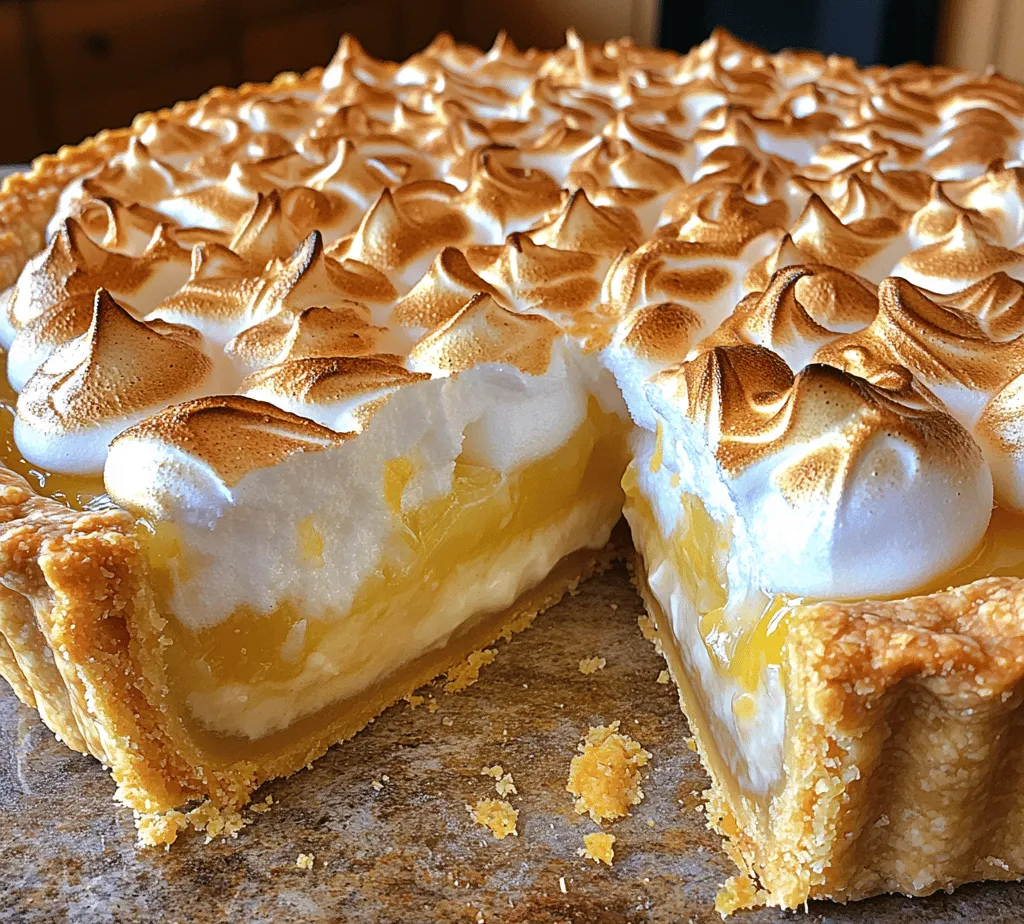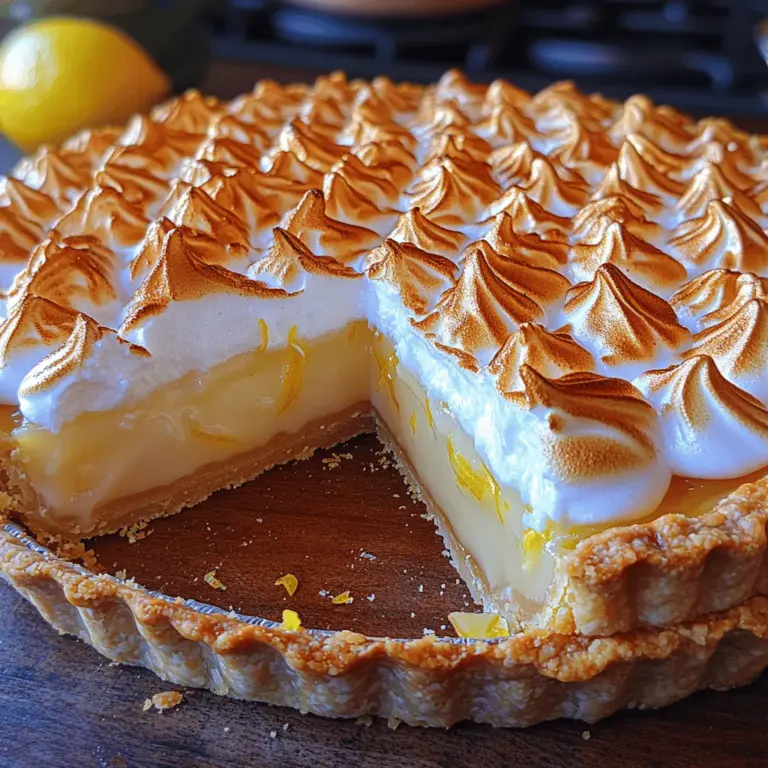Introduction to the Ultimate Lemon Meringue Pie
Embark on a culinary adventure as we explore the delightful creation of the Ultimate Lemon Meringue Pie. This classic dessert is renowned for its harmonious balance of tangy lemon filling, fluffy meringue, and a buttery crust. Lemon meringue pie has a storied history, believed to have originated in the 19th century and has since become a beloved staple in many households. It seamlessly combines the boldness of citrus with the lightness of meringue, creating a dessert that is both refreshing and indulgent.
Whether you are preparing for a family gathering, a holiday feast, or a special celebration, this pie is sure to impress. Its vibrant flavor and stunning appearance make it a showstopper at any event. In this article, you will find a comprehensive guide that details each step of the recipe, offering insights into techniques, flavor profiles, and the science behind this beloved dessert. From the flaky crust to the creamy filling and the airy topping, we will cover everything you need to know to achieve the ultimate lemon meringue pie.
Understanding the Components of Lemon Meringue Pie
To create the Ultimate Lemon Meringue Pie, it is essential to understand the key components that make this dessert irresistible. Each element plays a vital role in the overall flavor, texture, and presentation, making it crucial to approach the recipe with care and attention to detail.
The Crust: A Solid Foundation for Flavor
A well-made pie crust is the foundation upon which the entire lemon meringue pie is built. The crust serves not only as a vessel to hold the filling but also adds texture and flavor that complements the tartness of the lemon. An ideal crust is flaky, buttery, and has just the right amount of crunch, creating a delightful contrast to the smooth filling and airy meringue.
Importance of a Well-Made Pie Crust
The crust is often the unsung hero of many desserts, yet its importance cannot be overstated. A poorly made crust can lead to a soggy bottom or an overly tough texture, which can detract from the overall experience of enjoying the pie. By mastering the art of pie crust making, you set the stage for a delicious dessert.
Overview of Ingredients and Their Roles
A traditional pie crust typically contains just a few key ingredients: flour, butter, salt, and water. Each component has a specific function:
– Flour: The backbone of the crust, providing structure and stability.
– Butter: Adds flavor and richness while also contributing to the flakiness of the crust.
– Salt: Enhances the overall flavor profile, balancing the sweetness of the filling.
– Water: Hydrates the flour, allowing the dough to come together without becoming overly sticky.
By understanding the roles of these ingredients, you can make informed choices about how to manipulate them for the desired texture.
Techniques for Achieving the Perfect Texture
Achieving the perfect pie crust requires a few key techniques:
1. Cold Ingredients: Using cold butter and chilled water helps to create a flaky texture. The cold fat creates steam during baking, which results in those desirable flaky layers.
2. Minimal Mixing: Overworking the dough can lead to a tough crust. Mix the ingredients just until they come together, and avoid excessive handling.
3. Chilling the Dough: Allowing the dough to chill for at least 30 minutes before rolling it out helps to relax the gluten, making it easier to work with and resulting in a tender crust.
By mastering these techniques, you can lay the groundwork for a pie that boasts a perfectly baked crust.
The Lemon Filling: A Symphony of Citrus
The lemon filling is the star of the show in this dessert. It brings the much-loved tanginess that defines lemon meringue pie. The filling should strike a delicate balance between sweetness and tartness, creating a flavor explosion that tantalizes the taste buds.
Significance of Using Fresh Ingredients
When it comes to lemon filling, freshness is key. Using freshly squeezed lemon juice instead of bottled juice is essential for achieving the best flavor. Fresh lemons provide brightness and acidity that can elevate the dessert to new heights. The zest of the lemons also contributes to the aromatic qualities of the filling, adding a depth of flavor that is simply unmatched.
The Balance of Sweetness and Tartness
Creating the perfect lemon filling requires careful consideration of the sugar content. The sweetness should complement the tartness of the lemons without overpowering it. A successful balance will leave your taste buds dancing with delight. Typically, a combination of granulated sugar and cornstarch is used to achieve this balance, allowing the filling to set properly while also sweetening the tart lemon juice.
Step-by-Step Breakdown of the Cooking Process
1. Whisking the Ingredients: Begin by whisking together the sugar, cornstarch, and a pinch of salt in a saucepan. This mixture will help to thicken the filling as it cooks.
2. Adding Liquid: Gradually whisk in the water and lemon juice, ensuring that there are no lumps in the mixture.
3. Cooking the Filling: Place the saucepan over medium heat and continuously stir the mixture. As it heats up, it will begin to thicken. Continue stirring until it reaches a pudding-like consistency.
4. Incorporating Egg Yolks: Once the filling is thickened, remove it from the heat and temper the egg yolks by whisking a small amount of the hot filling into the yolks before adding them back to the saucepan. This step prevents the yolks from curdling.
5. Finishing Touches: Return the mixture to the heat and stir until everything is well combined and smooth. Remove from heat and add a pat of butter for richness, and finish with lemon zest for an extra burst of flavor.
With the lemon filling prepared, you are one step closer to creating your ultimate lemon meringue pie.
The Meringue: The Crowning Glory
The meringue is what sets lemon meringue pie apart from other desserts. It adds a light, airy texture that contrasts beautifully with the dense filling and flaky crust. Mastering meringue is essential to achieving that iconic finish.
Differences Between Soft and Stiff Peaks in Meringue
Meringue can be categorized into two types: soft peaks and stiff peaks. Understanding the difference is crucial for achieving the desired texture:
– Soft Peaks: When you lift the whisk out of the meringue, the peaks gently flop over. This stage is ideal for folding into batters or for lighter, fluffier desserts.
– Stiff Peaks: When the whisk is lifted, the peaks stand tall and firm. This stage is what you want for topping your lemon meringue pie, as it will hold its shape during baking and create an impressive presentation.
The Role of Cream of Tartar in Stabilization
Cream of tartar is a crucial ingredient when making meringue. It stabilizes the egg whites, helping to maintain their structure and prevent collapse. When added to the egg whites while they are being whipped, it helps create a glossy, stable meringue that can withstand the heat of the oven.
Techniques for Achieving a Beautifully Browned Top
1. Beating the Egg Whites: Start with room temperature egg whites for optimal volume. Beat them until they become frothy, then gradually add sugar while continuing to whip until stiff peaks form.
2. Spread the Meringue: Carefully spread the meringue over the lemon filling, making sure to seal the edges to prevent shrinkage during baking.
3. Baking: Bake the pie in a preheated oven at high heat for a short period, just long enough to brown the meringue without overcooking the filling.
With all the components understood, you’re ready to begin crafting the Ultimate Lemon Meringue Pie. In the next sections, we will provide a detailed, step-by-step guide to creating this classic dessert, ensuring that you have all the tools necessary for success.
Stay tuned as we delve into the specifics of creating the perfect pie crust and preparing the flavorful lemon filling, leading you one step closer to mastering this iconic dessert.

Incorporating Lemon Juice and Zest Effectively
To create the ultimate lemon meringue pie, the incorporation of fresh lemon juice and zest is paramount. The zest, the outer peel of the lemon, contains aromatic oils that enhance the flavor profile of your filling. Begin by zesting your lemons using a microplane or a fine grater. Aim for about 2 tablespoons of zest, which will contribute a vibrant lemony aroma to your pie.
When measuring out your lemon juice, ensure that you’re using freshly squeezed juice for the best taste. Approximately 3/4 cup of lemon juice is needed for the filling, which will provide the signature tanginess that balances the sweetness of the meringue. Combine the zest and juice in a medium mixing bowl before adding them to your other filling ingredients. This careful integration allows the flavors to meld beautifully, creating a refreshing and aromatic filling that will delight your taste buds.
Ensuring the Filling Achieves the Right Consistency
A crucial step in crafting a perfect lemon meringue pie is achieving the right consistency for your filling. To do this, start by whisking together the sugar, cornstarch, and salt in a saucepan. Gradually add water, lemon juice, and zest while stirring continuously to prevent any lumps.
Place the saucepan over medium heat, continuously whisking until the mixture begins to thicken and bubble. Once it reaches a bubbling point, continue to cook for an additional 2 minutes to ensure the cornstarch is fully activated, which will provide the filling with the right thickness.
Remove the saucepan from heat and stir in the egg yolks and butter until fully incorporated. It’s vital to temper the egg yolks by adding a small amount of the hot mixture to them, whisking quickly before returning them to the saucepan. This will prevent the yolks from cooking too quickly and scrambling. The final filling should be smooth, glossy, and spreadable—if it’s too runny, return it to the heat and cook for a minute or two longer.
Mastering the Meringue Topping
Whipping Egg Whites to Perfection
The meringue topping is what elevates your lemon meringue pie from good to extraordinary. Start with room temperature egg whites, as they whip up to a greater volume when they are not cold. To ensure there’s no grease in your mixing bowl, wash it with hot, soapy water and dry it thoroughly before beginning.
Using a stand mixer or a hand mixer, beat the egg whites on medium speed until they become frothy. At this stage, gradually increase the speed to high and continue beating until soft peaks form. This means that when you lift the beater, the peaks will curl over but still hold their shape.
Gradually Adding Sugar and Incorporating Flavors
Once you have achieved soft peaks, it’s time to slowly incorporate the sugar—about 1 cup in total. Add the sugar one tablespoon at a time, allowing each addition to dissolve completely before adding the next. This gradual process ensures a stable meringue.
After all the sugar has been added, continue whipping the egg whites until stiff peaks form. The meringue should be glossy and smooth, and when you lift the beater, the peaks should stand tall without drooping. For added flavor, you can incorporate a teaspoon of vanilla extract or a pinch of cream of tartar at this stage, which helps stabilize the meringue.
Techniques for Spreading Meringue and Sealing the Edges
With your meringue ready, it’s time to spread it over the lemon filling. Start in the center of the pie and gently spread the meringue to the edges, making sure to seal the meringue completely against the crust to prevent shrinkage during baking. Use a spatula to create decorative swirls or peaks on top, which will add visual appeal once baked.
Baking and Cooling: The Final Steps
Proper Baking Temperatures and Times
Preheat your oven to 350°F (175°C) for baking the meringue topping. Place the pie on the middle rack of the oven and bake for about 10 to 15 minutes, or until the meringue is golden brown. Keep a close eye on it to avoid burning, as meringue can change color quickly. The goal is a light golden hue that indicates a perfectly cooked meringue with a slightly crispy exterior.
Cooling and Setting the Pie for Optimal Texture
Once baked, remove the pie from the oven and allow it to cool at room temperature for at least an hour. This cooling process is essential as it allows the filling to set properly. After it has cooled, place the pie in the refrigerator for at least two hours before serving. This chilling time helps the filling firm up and melds the flavors perfectly.
Importance of Refrigeration Before Serving
Refrigerating your lemon meringue pie not only enhances its texture but also ensures that the meringue maintains its structure. If left at room temperature for too long, the meringue may weep, which can detract from the pie’s overall appearance and taste. For the best experience, serve it chilled, allowing the flavors to shine.
Serving Suggestions and Pairings
To enhance the experience of enjoying your lemon meringue pie, consider pairing it with various accompaniments. A dollop of freshly whipped cream or a scoop of vanilla ice cream can add creaminess that complements the tartness of the lemon. Fresh berries, such as strawberries or blueberries, can provide a delightful contrast in flavor and color on the plate.
For beverages, classic options like iced tea or lemonade can echo the citrusy notes of the pie, creating a harmonious dining experience. Alternatively, a light white wine or sparkling water can cleanse the palate between bites.
Presentation Ideas for Your Lemon Meringue Pie
When it comes to presentation, there are several creative serving styles you can adopt. Consider serving individual slices on decorative plates, garnished with a sprig of mint or a slice of lemon for a pop of color. Alternatively, serving the pie in a rustic style straight from the pie dish can evoke a homey, inviting atmosphere.
Garnishing with fresh fruits or herbs can elevate the visual appeal further. For example, a handful of fresh raspberries or slices of kiwi can offer a vibrant contrast to the golden meringue. Edible flowers can also add a touch of elegance and sophistication.
The Cultural Significance of Lemon Meringue Pie
Lemon meringue pie is not just a dessert; it carries a rich cultural significance and evokes nostalgia for many. Traditionally, it has been a popular dish in American households, often associated with family gatherings and festive occasions. Its bright flavors and textures make it a favorite among bakers and dessert lovers alike.
Origins and Evolution of the Recipe
The origins of lemon meringue pie can be traced back to the 19th century, with variations appearing in Europe long before it became a staple in American kitchens. The combination of lemon custard and meringue was likely influenced by the French and British dessert traditions. Over time, American bakers embraced this combination, leading to the classic version we know today.
Throughout its history, the recipe has seen numerous adaptations across different cultures, with variations that include different types of citrus or alternative crusts. Despite these changes, the core appeal of lemon meringue pie remains steadfast—a delightful balance of tangy and sweet that continues to charm dessert lovers everywhere.
The Pie’s Place in American Dessert Traditions
In American culture, lemon meringue pie has cemented its status as a beloved dessert. It often graces tables during holidays, family reunions, and potlucks, becoming a symbol of comfort and celebration. Many families have their own cherished recipes passed down through generations, each adding unique touches that reflect personal stories and traditions.
Conclusion: The Joy of Baking Lemon Meringue Pie
As we conclude our exploration of the ultimate lemon meringue pie, it’s evident that this dessert is more than just a treat; it’s a celebration of flavors and textures that bring joy to any table. Whether you are a seasoned baker or a novice in the kitchen, this recipe offers an opportunity to create something truly special. With its tangy filling, light meringue, and flaky crust, this pie embodies the essence of comfort food.
Enjoy the process of baking this delightful dessert, share it with loved ones, and savor each delightful slice. The smiles and satisfaction it brings will undoubtedly make the effort worthwhile. So, roll up your sleeves, gather your ingredients, and embark on the delightful journey of creating the ultimate lemon meringue pie!

